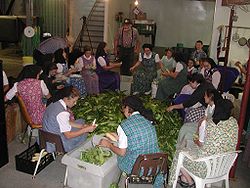Hutterite

Hutterite women at work
|
|
| Total population | |
|---|---|
| 45,000+ (2016) |
|
| Founder | |
| Jakob Hutter | |
| Regions with significant populations | |
| North America (notably South Dakota, North Dakota, Manitoba, and Alberta) | |
| Religions | |
| Anabaptist | |
| Scriptures | |
| The Bible | |
| Languages | |
| Bernese German, Hutterite German, Low Alemannic Alsatian German, English |
Hutterites (German: Hutterer) are an ethnoreligious group that is a communal branch of Anabaptists who, like the Amish and Mennonites, trace their roots to the Radical Reformation of the 16th century. Since the death of their eponym Jakob Hutter in 1536, the beliefs of the Hutterites, especially living in a community of goods and absolute pacifism, have resulted in hundreds of years of diaspora in many countries. Nearly extinct by the 18th and 19th centuries, the Hutterites found a new home in North America. Over 130 years their population grew from 400 to around 45,000. Today, most Hutterites live in Western Canada and the upper Great Plains of the United States.
Originating in the Austrian province of Tyrol in the 16th century, the forerunners of the Hutterites migrated to Moravia to escape persecution. There, under the leadership of Jakob Hutter, they developed the communal form of living based on the New Testament books of the Acts of the Apostles (Chapters 2 (especially Verse 44), 4, and 5) and 2 Corinthians—which distinguishes them from other Anabaptists such as the Amish and Mennonites.
A basic tenet of Hutterian society has always been absolute pacifism (nonresistance), forbidding its members from taking part in military activities, taking orders, wearing a formal uniform (such as a soldier's or a police officer's) or contributing to war taxes. This has led to expulsion or persecution in the several lands in which they have lived. In Moravia, the Hutterites flourished for over a century, until renewed persecution caused by the Austrian takeover of the Czech lands forced them once again to migrate, first to Transylvania, and, then, in the early 18th century, to Ukraine, in the Russian Empire. Some Hutterites converted to Catholicism and retained a separate ethnic identity in Slovakia as the Habans until the 19th century (by the end of World War II, the Haban group had become essentially extinct). At this time the number of Hutterites had fallen to around 100. In Ukraine, the Hutterites enjoyed relative prosperity, although their distinctive form of communal life was influenced by neighboring Russian Mennonites. In time, though, Russia had installed a new compulsory military service law, and the pressure was on again.
...
Wikipedia
